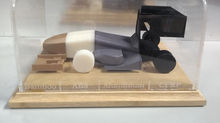EXPERIMENTAL MANUFACTURING METHODS
Though revision period is in full swing, the team have been keeping progression ticking along with developments across the car. Achieving more manufacture now, before the beginning of June, holds the team in good standings to be able to tune and test before Silverstone.
New 3D Printing Ventures:
The University has recently expanded their capabilities with a new carbon fibre 3D printer. While other types of 3D printing are great for rapid prototyping, this new 3D printer uses a blend of polymers and carbon fibre to produce a strong and robust component. Ollie Mitchell, one of our second year students, has designed a back plate for the steering wheel to integrate the paddle shifter onto the steering wheel. The back plate was printed overnight and reduced the cost massively as no CNC operations were required.

Other components, including pedal faces and the plenum, will be manufactured using the new printer to take full advantage of the great facilities on offer at the university.
Core to a good wing
Thanks to our new supplier, Foam Cutting UK, expanded foam inserts will be used for the inside of the wings. Not only will the cores help ensure the wings pass the strict rules surrounding aerodynamic devices, huge cost efficiencies have been gained in using this approach, compared to the standard 1-run mould boards typically required. The foam cores will also allow the opportunity for mounting options to be placed inside of the wing, further adding rigidity.

Using pre-preg carbon fibre, trial lay-ups of sections have given promising results for structural stiffness. As always always a big thank you to our sponsor SOLVAY for providing the carbon fibre material.
Keeping it cool at 45°
Following the 2018 car's fantastic cooling abilities, the 2019 car will again feature a 45° fin radiator, manufactured by Bespoke Motorsport Radiators.
The design, tailored to the demands of the 510cc engine, provides sufficient passive and active cooling to the engine when stationary and out on track. Having 45° fins maximises the amount of area the radiator cooling surface occupies, whilst also allowing optimum airflow through the inline fins.


Coupled with a revised cooling loop in the newly refurbished engine, the team are hoping to extract greater work from the unit as it is pushed to the limit time and time again. A more efficient, high flow fan is to be used in conjunction with the team's first cooling shroud, maximising the system efficiency as it only draws air through, and not around, the radiator.
We'd like to thank the team at BMR for delivering an excellent product!




















